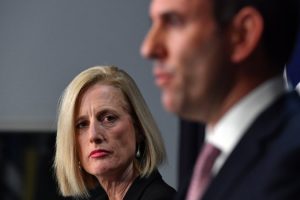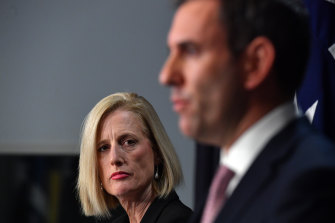Labor’s spending audit welcome, but budget trickery can cut both ways

There would be few people in Australia who enjoy a “line by line” audit of budget spending as much as I do.
So it is with open arms I welcome the decision by Treasurer Jim Chalmers and Finance Minister Katy Gallagher to instruct their respective mandarins in Treasury and finance to conduct a joint audit of the quality of government spending to identify areas of potential waste.
Finance Minister Katy Gallagher with Treasurer Jim Chalmers. They are overseeing a “line by line” examination of budget spending.Credit:AAP
Spending audits have proved a worthwhile exercise for many incoming governments, at both a state and federal level. They help incoming ministers to both familiarise themselves with the lay of the fiscal land, while also helping to hone their true priorities in government.
History shows there are potential political pitfalls, however, to outsourcing the task.
The incoming Abbott government memorably commissioned former Business Council of Australia boss Tony Shepherd to head its 2014 National Commission of Audit. Shepherd proposed about 86 controversial spending cuts, including introducing co-payments to visit the GP, a slowing in the rate of increase of the age pension and an increase in its eligibility age to 70.
Treasurer Joe Hockey’s bombshell 2014 budget, which incorporated many of the suggested cuts, proved so contentious, most of it never saw the light of legislative day.
Sadly, little has been done since to examine the sustainability and quality of government spending. With gross debt on a path to soon top $1 trillion, now does seem like an opportune time.
Incoming governments always decry, of course, the waste and mismanagement of their predecessors. Finding the politically palatable savings often proves the more difficult task.
Still, Labor does seem to have already identified some rich pickings.
Labor’s official policy costings document released just prior to the election accused former prime minister Scott Morrison of overseeing “a budget riddled with rorts and slush funds, and weighed down by waste”. It pledged to crack down on two such funds, axing $350 million in uncommitted funds from the community development grants program and a further $400 million from a regionalisation fund.
This is fertile territory indeed. Multiple analyses, including from journalists at this paper, have demonstrated how easily such grants programs and funds can be raided for political purposes on the eve of election, with money targeted at key marginal seats.
The Coalition’s official policy costings for this election only underscores the point. It detailed 36 “new” spending measures taken since the March budget. But in fact, a footnote revealed a swathe of other spending decisions had, in fact, been taken: “The Coalition has committed unallocated funds including from within the following programs: Community Development Grants Program, Energy Security and Regional Development Plan, Environment Restoration Fund, Infrastructure Investment Program, Regional Accelerator Program; Safer Communities Program, Strong and Resilient Communities Program.”
I’d be putting all those programs at the top of my spending audit if I were Treasury and finance.
Gallagher has also flagged that several multi-billion dollar infrastructure projects committed to by the previous Coalition government, and provisioned for under “contingent liabilities”, will be reviewed.
Funding projects “off balance sheet” has been an increasing trend recently and does little to improve budget transparency. Indeed, it’s almost as if that’s the point.
It was the Rudd government, of course, who decided to fund the National Broadband Network “off budget”. And, for a time, Labor’s plans for a carbon pollution reduction scheme also sat under “contingent liabilities”.
Which is only to say that both sides of politics have been guilty of some degree of budget trickery in recent years.
We in the media often oblige by forgetting spending which occurs beyond the budget’s four-year horizon or which sits “off balance sheet” in this way.
So, what will the impending audit make of Labor’s own election policy pledges which are about to become reality? Surely, these will also be subject to audit now?
Labor’s election costings document outlined 111 new spending commitments, including $31.3 million for “local multicultural projects”, $238 million for a “schools upgrade fund”, $4.8 million for “surf lifesaving clubs”, $266.4 million for “local community, sport and infrastructure projects”, $148.6 million for “local industry grants”, $367.2 million for a non-disclosed list of “infrastructure projects”.
And what will the audit say of Labor’s own plans to finance billions of dollars of new spending “off balance sheet” via three new proposed “funds”?
There will be a $20 billion Rewiring the Nation Fund, to be overseen by a new government-owned entity called the rewiring the nation corporation. Then there’s a $10 billion Housing Australia Future Fund to award money to social housing projects. And finally, there’s a new $15 billion National Reconstruction Fund to “rebuild Australia’s industrial base”.
The latter will have an independent board to decide projects. But in doing so, it will be somewhat hamstrung by the fact Labor has already earmarked $8 billion for specific sub-funds, including a $1.5 billion medical manufacturing fund, a $1 billion value-adding resources fund and $1 billion for a critical technologies fund.
That’s an awful lot of unallocated funds sitting “off balance sheet”. I look forward to reading Treasury and finance’s audit recommendations about those programs. The treasurer will commit to sharing those findings in public and in full, won’t he?
The Money with Jess newsletter helps you budget, earn, invest and enjoy your money. Sign up to get it every Sunday.
Most Viewed in Business
From our partners
Source: Read Full Article

